Analyzing Leadership & Management Theories and Their Impact
VerifiedAdded on 2023/06/12
|10
|2637
|221
Report
AI Summary
This report provides an examination of leadership and management theories, principles, and their impact on organizations. It begins by presenting various leadership theories, such as contingency and transformational leadership, and discusses the importance of both soft and hard skills for leaders. The report then explores different management theories, including scientific management and administrative management, highlighting the roles of planning, coordination, and employee motivation. It assesses various leadership and management styles, such as democratic and authoritarian approaches, and their effects on company performance. Furthermore, the report analyzes factors that influence organizational culture, emphasizing the importance of company values, policies, and customs. The report concludes that effective leadership and a positive organizational culture are crucial for motivating employees and achieving organizational goals.
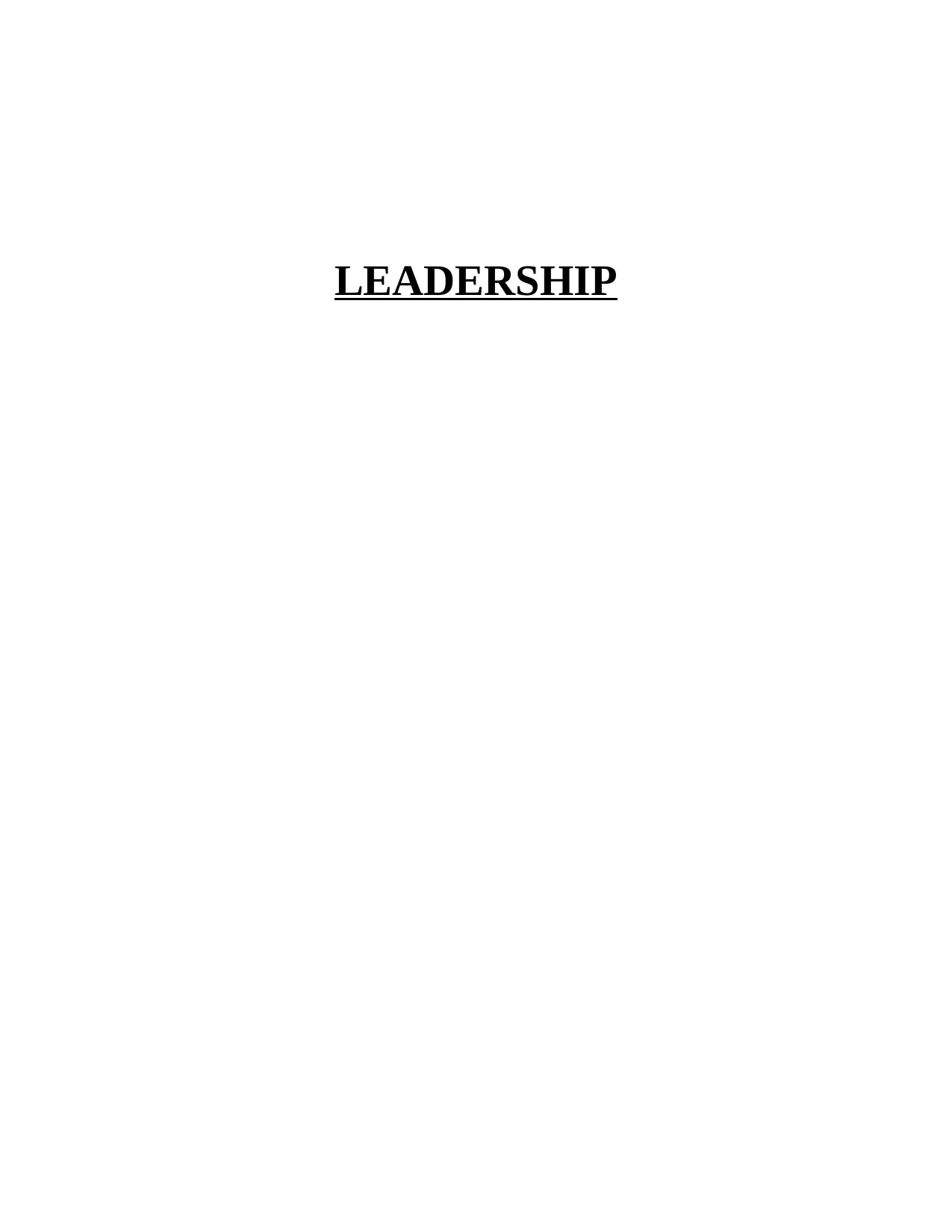
LEADERSHIP
Paraphrase This Document
Need a fresh take? Get an instant paraphrase of this document with our AI Paraphraser
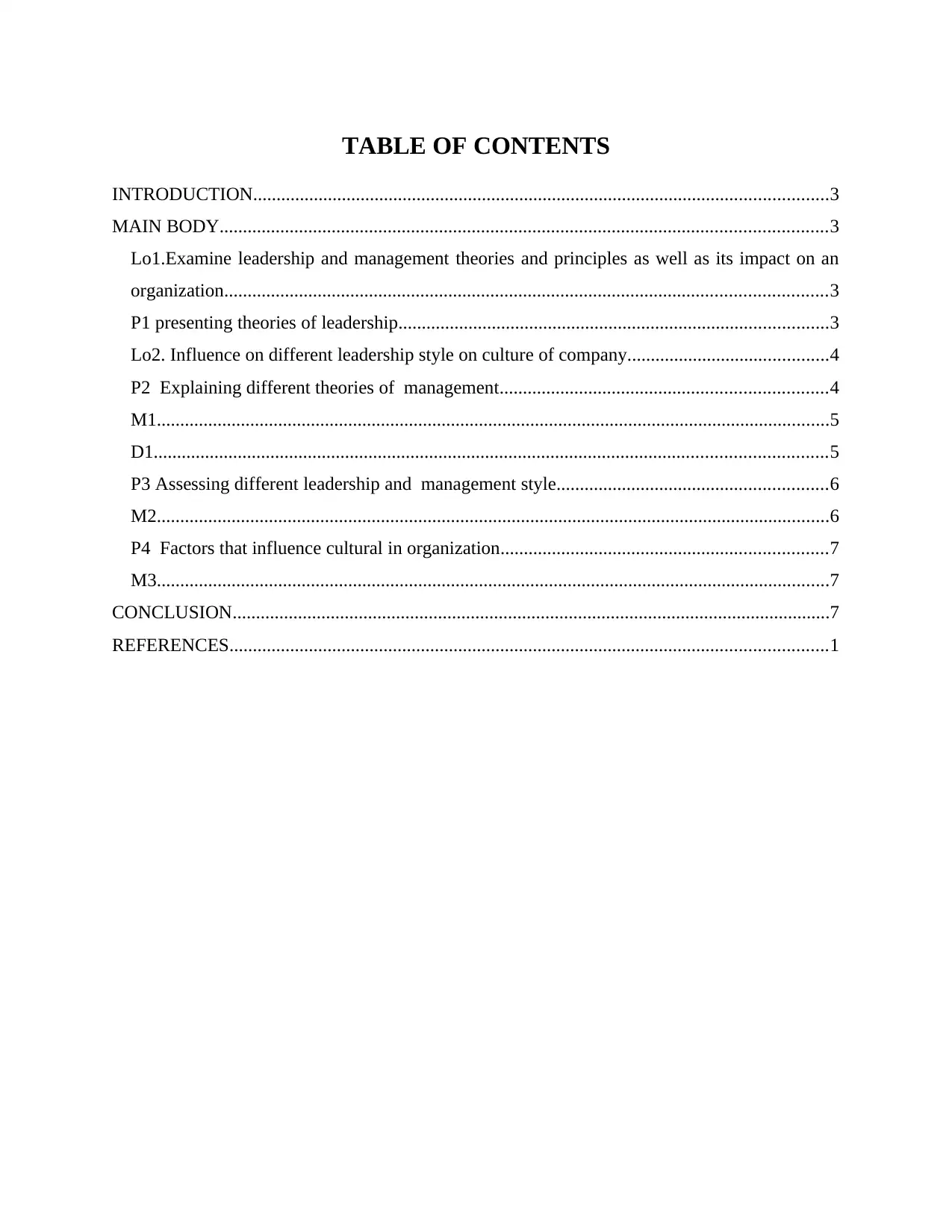
TABLE OF CONTENTS
INTRODUCTION...........................................................................................................................3
MAIN BODY..................................................................................................................................3
Lo1.Examine leadership and management theories and principles as well as its impact on an
organization.................................................................................................................................3
P1 presenting theories of leadership............................................................................................3
Lo2. Influence on different leadership style on culture of company...........................................4
P2 Explaining different theories of management......................................................................4
M1................................................................................................................................................5
D1................................................................................................................................................5
P3 Assessing different leadership and management style..........................................................6
M2................................................................................................................................................6
P4 Factors that influence cultural in organization......................................................................7
M3................................................................................................................................................7
CONCLUSION................................................................................................................................7
REFERENCES................................................................................................................................1
INTRODUCTION...........................................................................................................................3
MAIN BODY..................................................................................................................................3
Lo1.Examine leadership and management theories and principles as well as its impact on an
organization.................................................................................................................................3
P1 presenting theories of leadership............................................................................................3
Lo2. Influence on different leadership style on culture of company...........................................4
P2 Explaining different theories of management......................................................................4
M1................................................................................................................................................5
D1................................................................................................................................................5
P3 Assessing different leadership and management style..........................................................6
M2................................................................................................................................................6
P4 Factors that influence cultural in organization......................................................................7
M3................................................................................................................................................7
CONCLUSION................................................................................................................................7
REFERENCES................................................................................................................................1
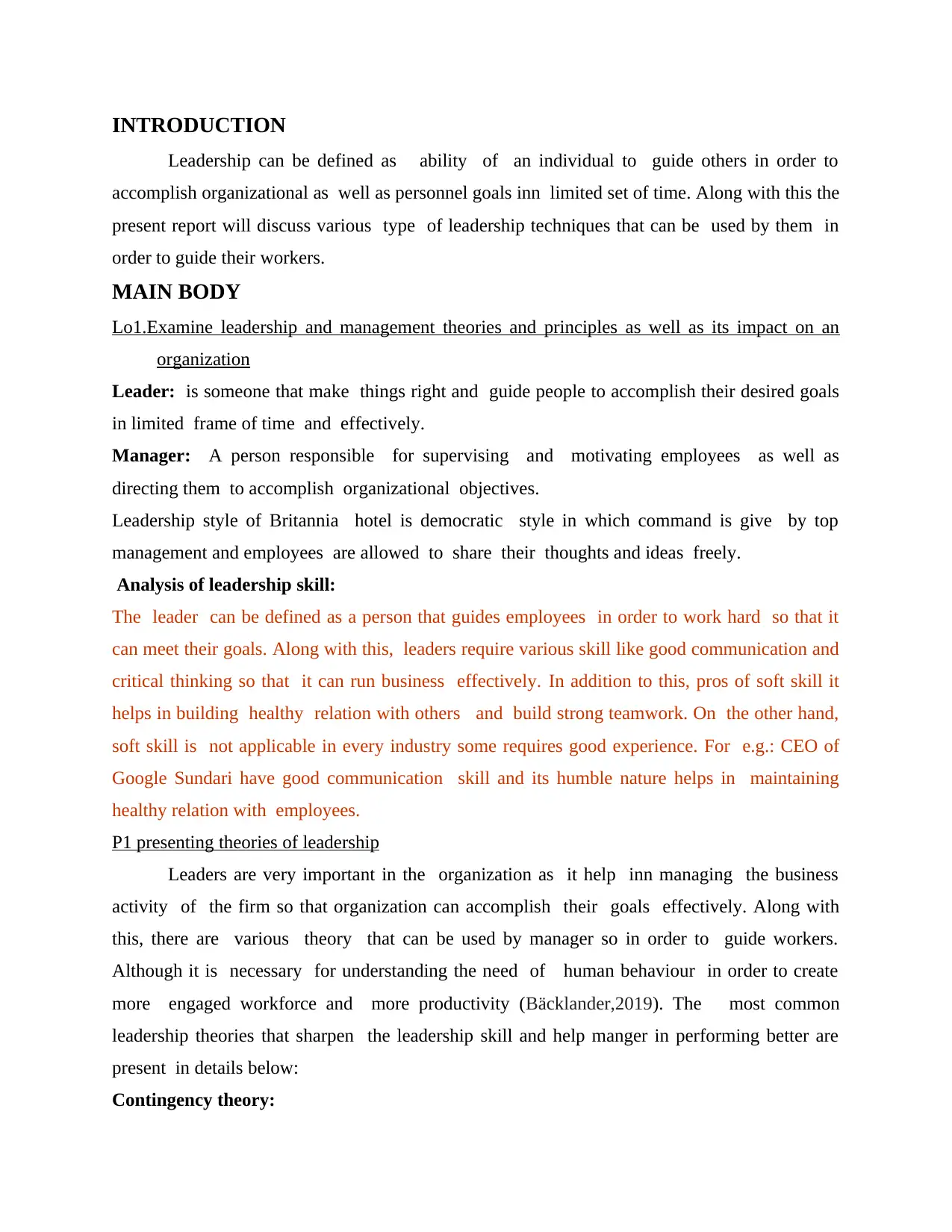
INTRODUCTION
Leadership can be defined as ability of an individual to guide others in order to
accomplish organizational as well as personnel goals inn limited set of time. Along with this the
present report will discuss various type of leadership techniques that can be used by them in
order to guide their workers.
MAIN BODY
Lo1.Examine leadership and management theories and principles as well as its impact on an
organization
Leader: is someone that make things right and guide people to accomplish their desired goals
in limited frame of time and effectively.
Manager: A person responsible for supervising and motivating employees as well as
directing them to accomplish organizational objectives.
Leadership style of Britannia hotel is democratic style in which command is give by top
management and employees are allowed to share their thoughts and ideas freely.
Analysis of leadership skill:
The leader can be defined as a person that guides employees in order to work hard so that it
can meet their goals. Along with this, leaders require various skill like good communication and
critical thinking so that it can run business effectively. In addition to this, pros of soft skill it
helps in building healthy relation with others and build strong teamwork. On the other hand,
soft skill is not applicable in every industry some requires good experience. For e.g.: CEO of
Google Sundari have good communication skill and its humble nature helps in maintaining
healthy relation with employees.
P1 presenting theories of leadership
Leaders are very important in the organization as it help inn managing the business
activity of the firm so that organization can accomplish their goals effectively. Along with
this, there are various theory that can be used by manager so in order to guide workers.
Although it is necessary for understanding the need of human behaviour in order to create
more engaged workforce and more productivity (Bäcklander,2019). The most common
leadership theories that sharpen the leadership skill and help manger in performing better are
present in details below:
Contingency theory:
Leadership can be defined as ability of an individual to guide others in order to
accomplish organizational as well as personnel goals inn limited set of time. Along with this the
present report will discuss various type of leadership techniques that can be used by them in
order to guide their workers.
MAIN BODY
Lo1.Examine leadership and management theories and principles as well as its impact on an
organization
Leader: is someone that make things right and guide people to accomplish their desired goals
in limited frame of time and effectively.
Manager: A person responsible for supervising and motivating employees as well as
directing them to accomplish organizational objectives.
Leadership style of Britannia hotel is democratic style in which command is give by top
management and employees are allowed to share their thoughts and ideas freely.
Analysis of leadership skill:
The leader can be defined as a person that guides employees in order to work hard so that it
can meet their goals. Along with this, leaders require various skill like good communication and
critical thinking so that it can run business effectively. In addition to this, pros of soft skill it
helps in building healthy relation with others and build strong teamwork. On the other hand,
soft skill is not applicable in every industry some requires good experience. For e.g.: CEO of
Google Sundari have good communication skill and its humble nature helps in maintaining
healthy relation with employees.
P1 presenting theories of leadership
Leaders are very important in the organization as it help inn managing the business
activity of the firm so that organization can accomplish their goals effectively. Along with
this, there are various theory that can be used by manager so in order to guide workers.
Although it is necessary for understanding the need of human behaviour in order to create
more engaged workforce and more productivity (Bäcklander,2019). The most common
leadership theories that sharpen the leadership skill and help manger in performing better are
present in details below:
Contingency theory:
⊘ This is a preview!⊘
Do you want full access?
Subscribe today to unlock all pages.

Trusted by 1+ million students worldwide
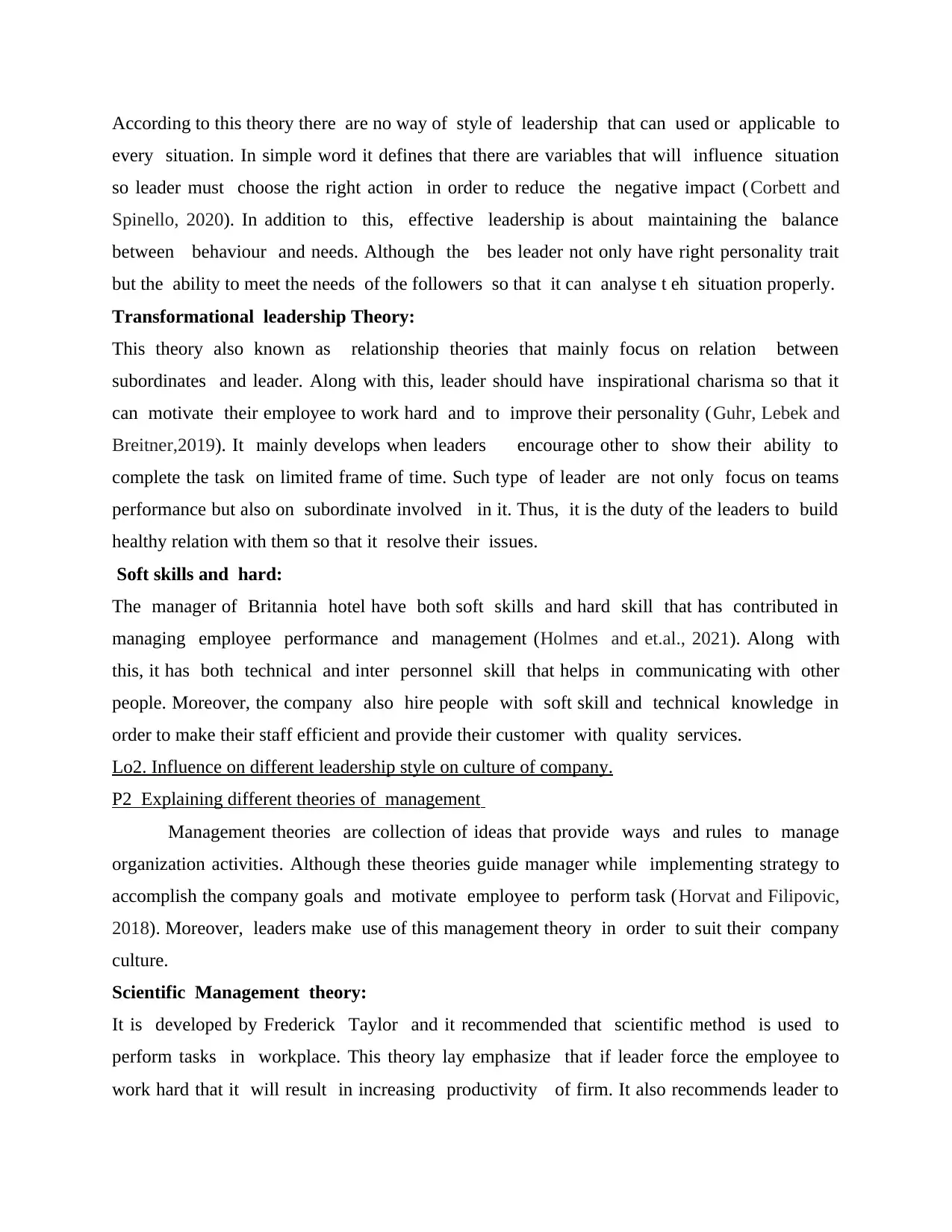
According to this theory there are no way of style of leadership that can used or applicable to
every situation. In simple word it defines that there are variables that will influence situation
so leader must choose the right action in order to reduce the negative impact ( Corbett and
Spinello, 2020). In addition to this, effective leadership is about maintaining the balance
between behaviour and needs. Although the bes leader not only have right personality trait
but the ability to meet the needs of the followers so that it can analyse t eh situation properly.
Transformational leadership Theory:
This theory also known as relationship theories that mainly focus on relation between
subordinates and leader. Along with this, leader should have inspirational charisma so that it
can motivate their employee to work hard and to improve their personality (Guhr, Lebek and
Breitner,2019). It mainly develops when leaders encourage other to show their ability to
complete the task on limited frame of time. Such type of leader are not only focus on teams
performance but also on subordinate involved in it. Thus, it is the duty of the leaders to build
healthy relation with them so that it resolve their issues.
Soft skills and hard:
The manager of Britannia hotel have both soft skills and hard skill that has contributed in
managing employee performance and management (Holmes and et.al., 2021). Along with
this, it has both technical and inter personnel skill that helps in communicating with other
people. Moreover, the company also hire people with soft skill and technical knowledge in
order to make their staff efficient and provide their customer with quality services.
Lo2. Influence on different leadership style on culture of company.
P2 Explaining different theories of management
Management theories are collection of ideas that provide ways and rules to manage
organization activities. Although these theories guide manager while implementing strategy to
accomplish the company goals and motivate employee to perform task (Horvat and Filipovic,
2018). Moreover, leaders make use of this management theory in order to suit their company
culture.
Scientific Management theory:
It is developed by Frederick Taylor and it recommended that scientific method is used to
perform tasks in workplace. This theory lay emphasize that if leader force the employee to
work hard that it will result in increasing productivity of firm. It also recommends leader to
every situation. In simple word it defines that there are variables that will influence situation
so leader must choose the right action in order to reduce the negative impact ( Corbett and
Spinello, 2020). In addition to this, effective leadership is about maintaining the balance
between behaviour and needs. Although the bes leader not only have right personality trait
but the ability to meet the needs of the followers so that it can analyse t eh situation properly.
Transformational leadership Theory:
This theory also known as relationship theories that mainly focus on relation between
subordinates and leader. Along with this, leader should have inspirational charisma so that it
can motivate their employee to work hard and to improve their personality (Guhr, Lebek and
Breitner,2019). It mainly develops when leaders encourage other to show their ability to
complete the task on limited frame of time. Such type of leader are not only focus on teams
performance but also on subordinate involved in it. Thus, it is the duty of the leaders to build
healthy relation with them so that it resolve their issues.
Soft skills and hard:
The manager of Britannia hotel have both soft skills and hard skill that has contributed in
managing employee performance and management (Holmes and et.al., 2021). Along with
this, it has both technical and inter personnel skill that helps in communicating with other
people. Moreover, the company also hire people with soft skill and technical knowledge in
order to make their staff efficient and provide their customer with quality services.
Lo2. Influence on different leadership style on culture of company.
P2 Explaining different theories of management
Management theories are collection of ideas that provide ways and rules to manage
organization activities. Although these theories guide manager while implementing strategy to
accomplish the company goals and motivate employee to perform task (Horvat and Filipovic,
2018). Moreover, leaders make use of this management theory in order to suit their company
culture.
Scientific Management theory:
It is developed by Frederick Taylor and it recommended that scientific method is used to
perform tasks in workplace. This theory lay emphasize that if leader force the employee to
work hard that it will result in increasing productivity of firm. It also recommends leader to
Paraphrase This Document
Need a fresh take? Get an instant paraphrase of this document with our AI Paraphraser
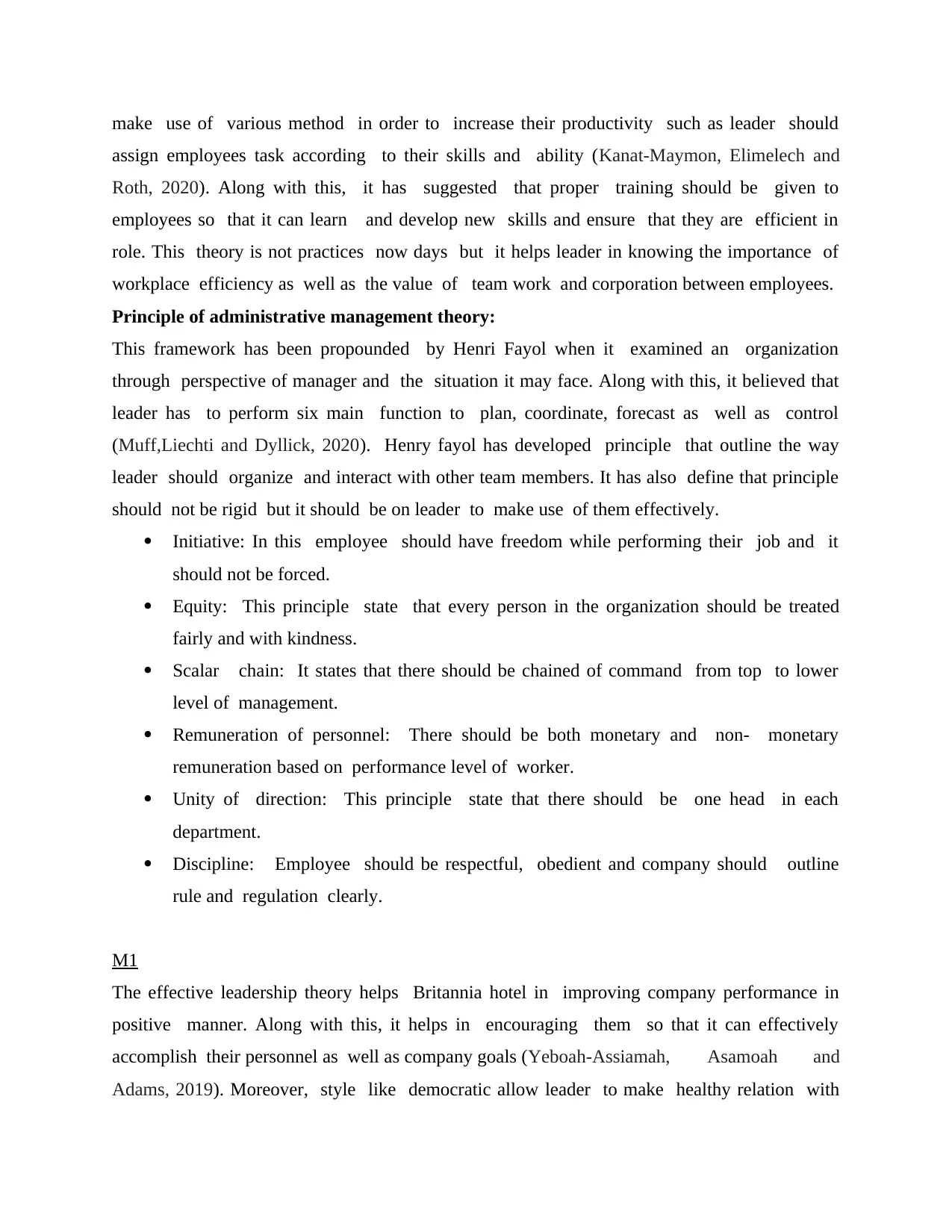
make use of various method in order to increase their productivity such as leader should
assign employees task according to their skills and ability (Kanat-Maymon, Elimelech and
Roth, 2020). Along with this, it has suggested that proper training should be given to
employees so that it can learn and develop new skills and ensure that they are efficient in
role. This theory is not practices now days but it helps leader in knowing the importance of
workplace efficiency as well as the value of team work and corporation between employees.
Principle of administrative management theory:
This framework has been propounded by Henri Fayol when it examined an organization
through perspective of manager and the situation it may face. Along with this, it believed that
leader has to perform six main function to plan, coordinate, forecast as well as control
(Muff,Liechti and Dyllick, 2020). Henry fayol has developed principle that outline the way
leader should organize and interact with other team members. It has also define that principle
should not be rigid but it should be on leader to make use of them effectively.
Initiative: In this employee should have freedom while performing their job and it
should not be forced.
Equity: This principle state that every person in the organization should be treated
fairly and with kindness.
Scalar chain: It states that there should be chained of command from top to lower
level of management.
Remuneration of personnel: There should be both monetary and non- monetary
remuneration based on performance level of worker.
Unity of direction: This principle state that there should be one head in each
department.
Discipline: Employee should be respectful, obedient and company should outline
rule and regulation clearly.
M1
The effective leadership theory helps Britannia hotel in improving company performance in
positive manner. Along with this, it helps in encouraging them so that it can effectively
accomplish their personnel as well as company goals (Yeboah‐Assiamah, Asamoah and
Adams, 2019). Moreover, style like democratic allow leader to make healthy relation with
assign employees task according to their skills and ability (Kanat-Maymon, Elimelech and
Roth, 2020). Along with this, it has suggested that proper training should be given to
employees so that it can learn and develop new skills and ensure that they are efficient in
role. This theory is not practices now days but it helps leader in knowing the importance of
workplace efficiency as well as the value of team work and corporation between employees.
Principle of administrative management theory:
This framework has been propounded by Henri Fayol when it examined an organization
through perspective of manager and the situation it may face. Along with this, it believed that
leader has to perform six main function to plan, coordinate, forecast as well as control
(Muff,Liechti and Dyllick, 2020). Henry fayol has developed principle that outline the way
leader should organize and interact with other team members. It has also define that principle
should not be rigid but it should be on leader to make use of them effectively.
Initiative: In this employee should have freedom while performing their job and it
should not be forced.
Equity: This principle state that every person in the organization should be treated
fairly and with kindness.
Scalar chain: It states that there should be chained of command from top to lower
level of management.
Remuneration of personnel: There should be both monetary and non- monetary
remuneration based on performance level of worker.
Unity of direction: This principle state that there should be one head in each
department.
Discipline: Employee should be respectful, obedient and company should outline
rule and regulation clearly.
M1
The effective leadership theory helps Britannia hotel in improving company performance in
positive manner. Along with this, it helps in encouraging them so that it can effectively
accomplish their personnel as well as company goals (Yeboah‐Assiamah, Asamoah and
Adams, 2019). Moreover, style like democratic allow leader to make healthy relation with
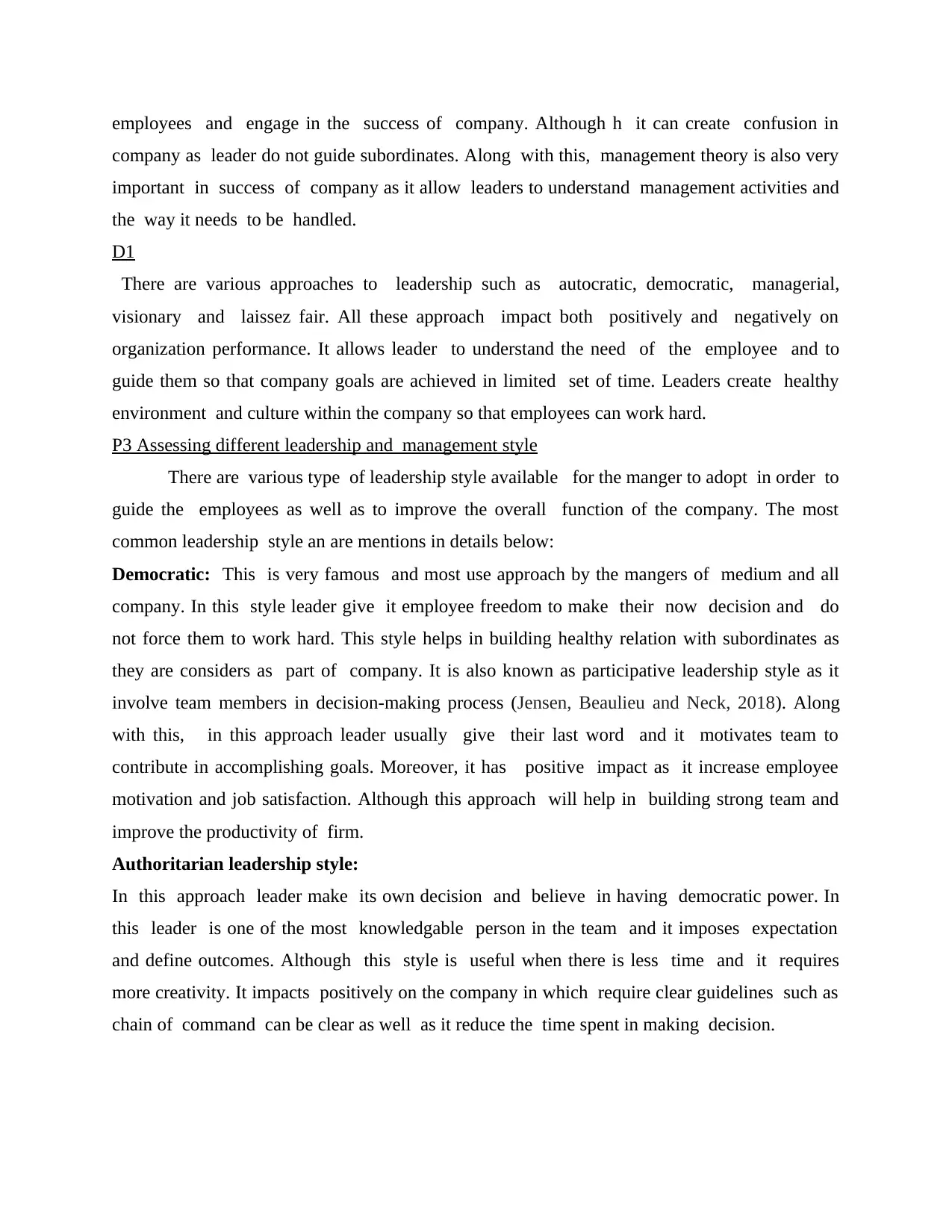
employees and engage in the success of company. Although h it can create confusion in
company as leader do not guide subordinates. Along with this, management theory is also very
important in success of company as it allow leaders to understand management activities and
the way it needs to be handled.
D1
There are various approaches to leadership such as autocratic, democratic, managerial,
visionary and laissez fair. All these approach impact both positively and negatively on
organization performance. It allows leader to understand the need of the employee and to
guide them so that company goals are achieved in limited set of time. Leaders create healthy
environment and culture within the company so that employees can work hard.
P3 Assessing different leadership and management style
There are various type of leadership style available for the manger to adopt in order to
guide the employees as well as to improve the overall function of the company. The most
common leadership style an are mentions in details below:
Democratic: This is very famous and most use approach by the mangers of medium and all
company. In this style leader give it employee freedom to make their now decision and do
not force them to work hard. This style helps in building healthy relation with subordinates as
they are considers as part of company. It is also known as participative leadership style as it
involve team members in decision-making process (Jensen, Beaulieu and Neck, 2018). Along
with this, in this approach leader usually give their last word and it motivates team to
contribute in accomplishing goals. Moreover, it has positive impact as it increase employee
motivation and job satisfaction. Although this approach will help in building strong team and
improve the productivity of firm.
Authoritarian leadership style:
In this approach leader make its own decision and believe in having democratic power. In
this leader is one of the most knowledgable person in the team and it imposes expectation
and define outcomes. Although this style is useful when there is less time and it requires
more creativity. It impacts positively on the company in which require clear guidelines such as
chain of command can be clear as well as it reduce the time spent in making decision.
company as leader do not guide subordinates. Along with this, management theory is also very
important in success of company as it allow leaders to understand management activities and
the way it needs to be handled.
D1
There are various approaches to leadership such as autocratic, democratic, managerial,
visionary and laissez fair. All these approach impact both positively and negatively on
organization performance. It allows leader to understand the need of the employee and to
guide them so that company goals are achieved in limited set of time. Leaders create healthy
environment and culture within the company so that employees can work hard.
P3 Assessing different leadership and management style
There are various type of leadership style available for the manger to adopt in order to
guide the employees as well as to improve the overall function of the company. The most
common leadership style an are mentions in details below:
Democratic: This is very famous and most use approach by the mangers of medium and all
company. In this style leader give it employee freedom to make their now decision and do
not force them to work hard. This style helps in building healthy relation with subordinates as
they are considers as part of company. It is also known as participative leadership style as it
involve team members in decision-making process (Jensen, Beaulieu and Neck, 2018). Along
with this, in this approach leader usually give their last word and it motivates team to
contribute in accomplishing goals. Moreover, it has positive impact as it increase employee
motivation and job satisfaction. Although this approach will help in building strong team and
improve the productivity of firm.
Authoritarian leadership style:
In this approach leader make its own decision and believe in having democratic power. In
this leader is one of the most knowledgable person in the team and it imposes expectation
and define outcomes. Although this style is useful when there is less time and it requires
more creativity. It impacts positively on the company in which require clear guidelines such as
chain of command can be clear as well as it reduce the time spent in making decision.
⊘ This is a preview!⊘
Do you want full access?
Subscribe today to unlock all pages.

Trusted by 1+ million students worldwide
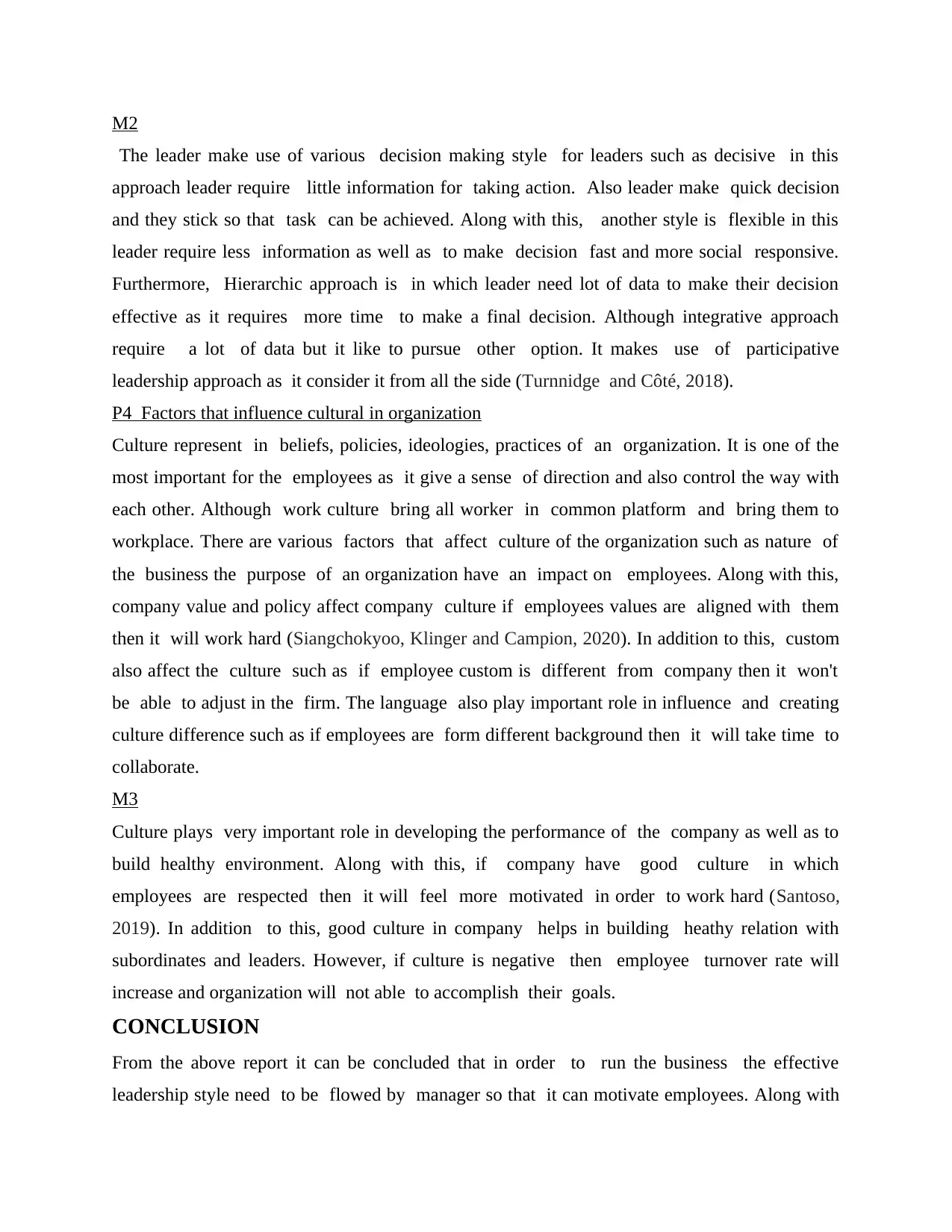
M2
The leader make use of various decision making style for leaders such as decisive in this
approach leader require little information for taking action. Also leader make quick decision
and they stick so that task can be achieved. Along with this, another style is flexible in this
leader require less information as well as to make decision fast and more social responsive.
Furthermore, Hierarchic approach is in which leader need lot of data to make their decision
effective as it requires more time to make a final decision. Although integrative approach
require a lot of data but it like to pursue other option. It makes use of participative
leadership approach as it consider it from all the side (Turnnidge and Côté, 2018).
P4 Factors that influence cultural in organization
Culture represent in beliefs, policies, ideologies, practices of an organization. It is one of the
most important for the employees as it give a sense of direction and also control the way with
each other. Although work culture bring all worker in common platform and bring them to
workplace. There are various factors that affect culture of the organization such as nature of
the business the purpose of an organization have an impact on employees. Along with this,
company value and policy affect company culture if employees values are aligned with them
then it will work hard (Siangchokyoo, Klinger and Campion, 2020). In addition to this, custom
also affect the culture such as if employee custom is different from company then it won't
be able to adjust in the firm. The language also play important role in influence and creating
culture difference such as if employees are form different background then it will take time to
collaborate.
M3
Culture plays very important role in developing the performance of the company as well as to
build healthy environment. Along with this, if company have good culture in which
employees are respected then it will feel more motivated in order to work hard (Santoso,
2019). In addition to this, good culture in company helps in building heathy relation with
subordinates and leaders. However, if culture is negative then employee turnover rate will
increase and organization will not able to accomplish their goals.
CONCLUSION
From the above report it can be concluded that in order to run the business the effective
leadership style need to be flowed by manager so that it can motivate employees. Along with
The leader make use of various decision making style for leaders such as decisive in this
approach leader require little information for taking action. Also leader make quick decision
and they stick so that task can be achieved. Along with this, another style is flexible in this
leader require less information as well as to make decision fast and more social responsive.
Furthermore, Hierarchic approach is in which leader need lot of data to make their decision
effective as it requires more time to make a final decision. Although integrative approach
require a lot of data but it like to pursue other option. It makes use of participative
leadership approach as it consider it from all the side (Turnnidge and Côté, 2018).
P4 Factors that influence cultural in organization
Culture represent in beliefs, policies, ideologies, practices of an organization. It is one of the
most important for the employees as it give a sense of direction and also control the way with
each other. Although work culture bring all worker in common platform and bring them to
workplace. There are various factors that affect culture of the organization such as nature of
the business the purpose of an organization have an impact on employees. Along with this,
company value and policy affect company culture if employees values are aligned with them
then it will work hard (Siangchokyoo, Klinger and Campion, 2020). In addition to this, custom
also affect the culture such as if employee custom is different from company then it won't
be able to adjust in the firm. The language also play important role in influence and creating
culture difference such as if employees are form different background then it will take time to
collaborate.
M3
Culture plays very important role in developing the performance of the company as well as to
build healthy environment. Along with this, if company have good culture in which
employees are respected then it will feel more motivated in order to work hard (Santoso,
2019). In addition to this, good culture in company helps in building heathy relation with
subordinates and leaders. However, if culture is negative then employee turnover rate will
increase and organization will not able to accomplish their goals.
CONCLUSION
From the above report it can be concluded that in order to run the business the effective
leadership style need to be flowed by manager so that it can motivate employees. Along with
Paraphrase This Document
Need a fresh take? Get an instant paraphrase of this document with our AI Paraphraser

this, the report has also concluded on management theory that can be used by firm in order to
avoid risk.
avoid risk.
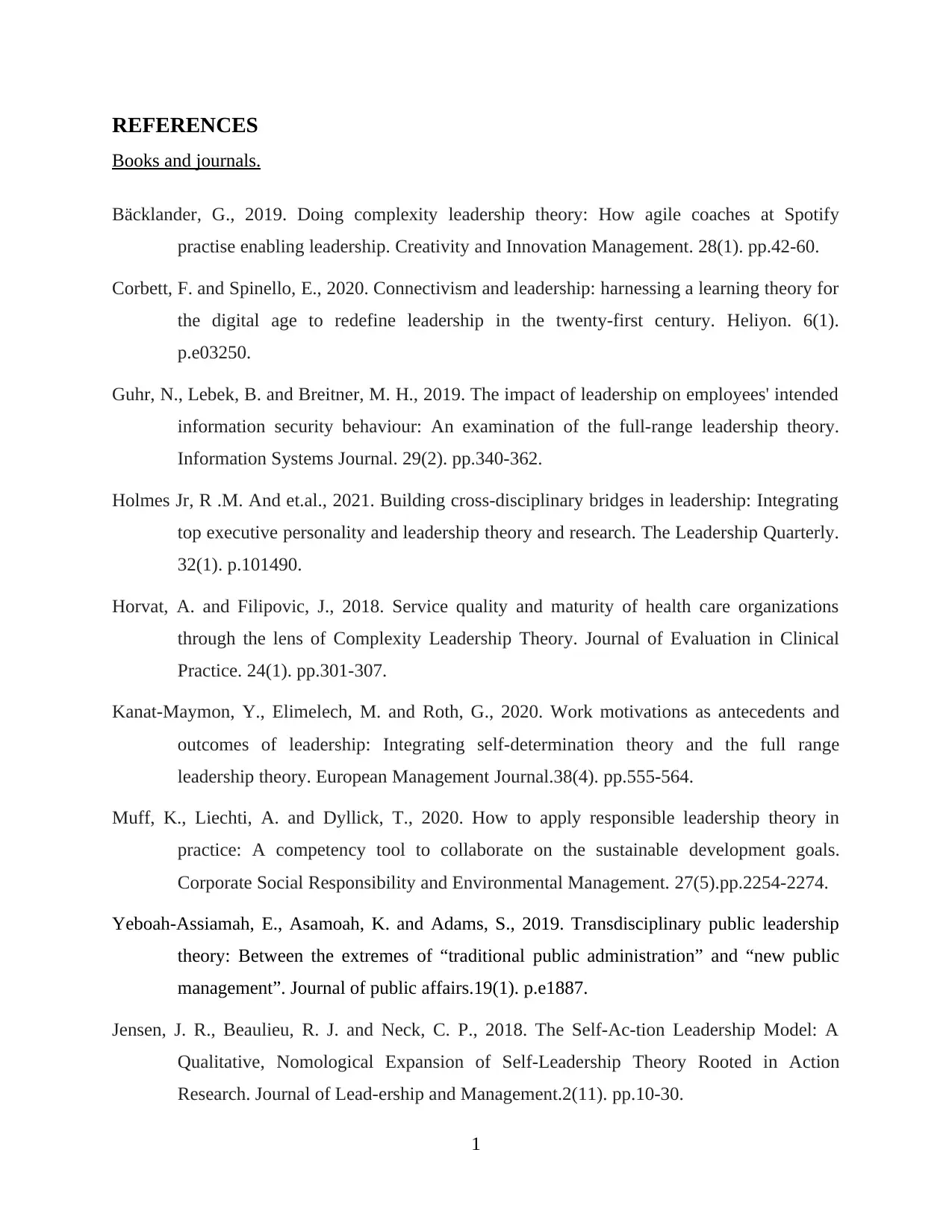
REFERENCES
Books and journals.
Bäcklander, G., 2019. Doing complexity leadership theory: How agile coaches at Spotify
practise enabling leadership. Creativity and Innovation Management. 28(1). pp.42-60.
Corbett, F. and Spinello, E., 2020. Connectivism and leadership: harnessing a learning theory for
the digital age to redefine leadership in the twenty-first century. Heliyon. 6(1).
p.e03250.
Guhr, N., Lebek, B. and Breitner, M. H., 2019. The impact of leadership on employees' intended
information security behaviour: An examination of the full‐range leadership theory.
Information Systems Journal. 29(2). pp.340-362.
Holmes Jr, R .M. And et.al., 2021. Building cross-disciplinary bridges in leadership: Integrating
top executive personality and leadership theory and research. The Leadership Quarterly.
32(1). p.101490.
Horvat, A. and Filipovic, J., 2018. Service quality and maturity of health care organizations
through the lens of Complexity Leadership Theory. Journal of Evaluation in Clinical
Practice. 24(1). pp.301-307.
Kanat-Maymon, Y., Elimelech, M. and Roth, G., 2020. Work motivations as antecedents and
outcomes of leadership: Integrating self-determination theory and the full range
leadership theory. European Management Journal.38(4). pp.555-564.
Muff, K., Liechti, A. and Dyllick, T., 2020. How to apply responsible leadership theory in
practice: A competency tool to collaborate on the sustainable development goals.
Corporate Social Responsibility and Environmental Management. 27(5).pp.2254-2274.
Yeboah‐Assiamah, E., Asamoah, K. and Adams, S., 2019. Transdisciplinary public leadership
theory: Between the extremes of “traditional public administration” and “new public
management”. Journal of public affairs.19(1). p.e1887.
Jensen, J. R., Beaulieu, R. J. and Neck, C. P., 2018. The Self-Ac-tion Leadership Model: A
Qualitative, Nomological Expansion of Self-Leadership Theory Rooted in Action
Research. Journal of Lead-ership and Management.2(11). pp.10-30.
1
Books and journals.
Bäcklander, G., 2019. Doing complexity leadership theory: How agile coaches at Spotify
practise enabling leadership. Creativity and Innovation Management. 28(1). pp.42-60.
Corbett, F. and Spinello, E., 2020. Connectivism and leadership: harnessing a learning theory for
the digital age to redefine leadership in the twenty-first century. Heliyon. 6(1).
p.e03250.
Guhr, N., Lebek, B. and Breitner, M. H., 2019. The impact of leadership on employees' intended
information security behaviour: An examination of the full‐range leadership theory.
Information Systems Journal. 29(2). pp.340-362.
Holmes Jr, R .M. And et.al., 2021. Building cross-disciplinary bridges in leadership: Integrating
top executive personality and leadership theory and research. The Leadership Quarterly.
32(1). p.101490.
Horvat, A. and Filipovic, J., 2018. Service quality and maturity of health care organizations
through the lens of Complexity Leadership Theory. Journal of Evaluation in Clinical
Practice. 24(1). pp.301-307.
Kanat-Maymon, Y., Elimelech, M. and Roth, G., 2020. Work motivations as antecedents and
outcomes of leadership: Integrating self-determination theory and the full range
leadership theory. European Management Journal.38(4). pp.555-564.
Muff, K., Liechti, A. and Dyllick, T., 2020. How to apply responsible leadership theory in
practice: A competency tool to collaborate on the sustainable development goals.
Corporate Social Responsibility and Environmental Management. 27(5).pp.2254-2274.
Yeboah‐Assiamah, E., Asamoah, K. and Adams, S., 2019. Transdisciplinary public leadership
theory: Between the extremes of “traditional public administration” and “new public
management”. Journal of public affairs.19(1). p.e1887.
Jensen, J. R., Beaulieu, R. J. and Neck, C. P., 2018. The Self-Ac-tion Leadership Model: A
Qualitative, Nomological Expansion of Self-Leadership Theory Rooted in Action
Research. Journal of Lead-ership and Management.2(11). pp.10-30.
1
⊘ This is a preview!⊘
Do you want full access?
Subscribe today to unlock all pages.

Trusted by 1+ million students worldwide

Santoso, C. B., 2019. Exploration of Asia leadership theory: Looking for an Asian role in the
field of leadership theory. Journal of Leadership in Organizations. 1(1).
Siangchokyoo, N., Klinger, R. L. and Campion, E. D., 2020. Follower transformation as the
linchpin of transformational leadership theory: A systematic review and future research
agenda. The Leadership Quarterly. 31(1). p.101341.
Turnnidge, J. and Côté, J., 2018. Applying transformational leadership theory to coaching
research in youth sport: A systematic literature review. International Journal of Sport
and Exercise Psychology.16(3). pp.327-342.
2
field of leadership theory. Journal of Leadership in Organizations. 1(1).
Siangchokyoo, N., Klinger, R. L. and Campion, E. D., 2020. Follower transformation as the
linchpin of transformational leadership theory: A systematic review and future research
agenda. The Leadership Quarterly. 31(1). p.101341.
Turnnidge, J. and Côté, J., 2018. Applying transformational leadership theory to coaching
research in youth sport: A systematic literature review. International Journal of Sport
and Exercise Psychology.16(3). pp.327-342.
2
1 out of 10
Related Documents
Your All-in-One AI-Powered Toolkit for Academic Success.
+13062052269
info@desklib.com
Available 24*7 on WhatsApp / Email
![[object Object]](/_next/static/media/star-bottom.7253800d.svg)
Unlock your academic potential
Copyright © 2020–2025 A2Z Services. All Rights Reserved. Developed and managed by ZUCOL.



